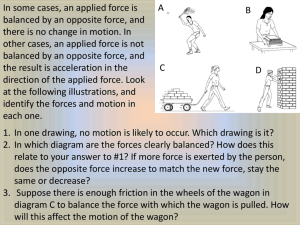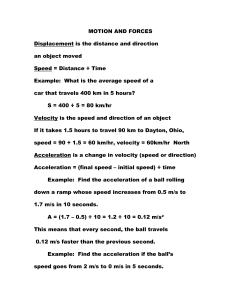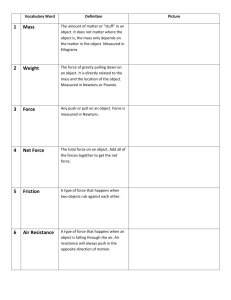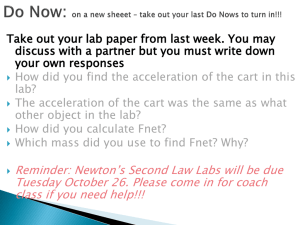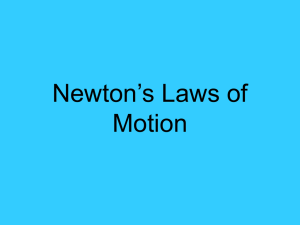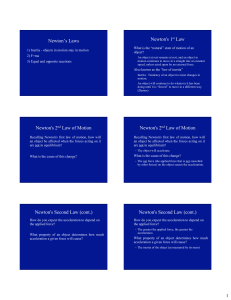Newton's Laws
advertisement
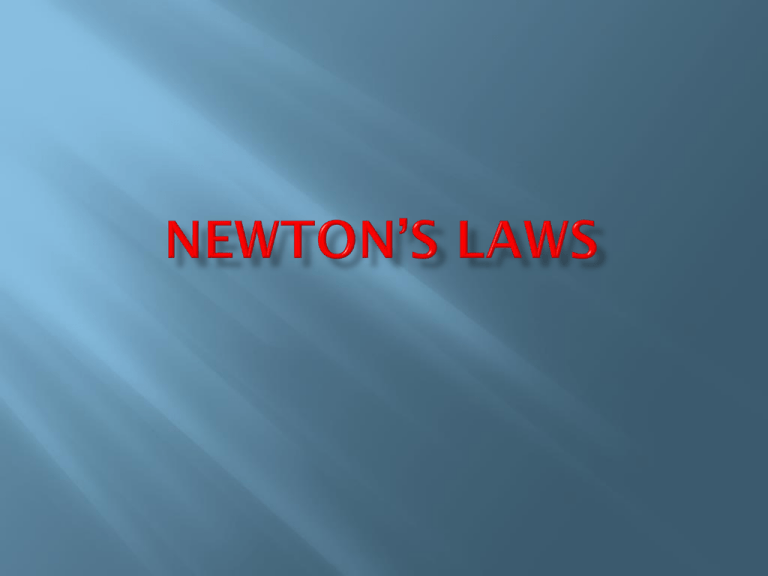
1) What are Newton’s three Laws of Motion? 2) When do we apply the three Laws of Motion? Newton’s first law of motion states that an object at rest remains at rest and an object in motion maintains its velocity unless it experiences an unbalanced force. Objects tend to maintain their state of motion. Inertia is the tendency of an object to resist being moved or, if the object is moving, to resist a change in speed or direction until an outside force acts on the object. Newton’s second law of motion states that the unbalanced force acting on an object equals the object’s mass times its acceleration. Force equals mass times acceleration. Force = mass acceleration F = ma Forces have the ability to accelerate an object. Force is measured in newtons (N). 1 N = 1 kg 1 m/s2 Newton’s third law of motion states that for every action force, there is an equal and opposite reaction force. Forces always occur in action-reaction pairs. Action-reaction force pairs are equal in size and opposite in direction. Force pairs do not act on the same object. They act on two different objects Which of Newton’s Laws Apply to the following situations? Discuss with your partners and prepare to share your answer with the class. 1. 2. 3. 4. 5. A heavier object is harder to move than a lighter object. “Seatbelts save lives.” When you push on a wall it pushes back with equal force. The Voyager spacecrafts, launched in the 1977, continue to travel deeper into space even though their jet engines ran out of fuel a long time ago. A rocket ship launching into space> Answers can vary: 1) 2nd Law (F=MA) or 1st Law as the more mass you have the greater your inertia. 2) 3) 4) 5) 1st Law 3rd Law 1st Law 3rd Law 2. What is the net force on a 2.0 kg weight hanging motionless on a string? (Hint: acceleration rate of gravity is 9.8 m/s2 A. 0.0 N B. 2.0 N C. 9.8 N D. 19.6 N 3. When a ball is falling toward Earth, what is the reaction force to the pull of gravity on the ball? F. air pressure pushing up on the ball G. force of the ground against the ball H. upward pull of the ball on Earth I. pull of gravity on the ball toward Earth Answers: 2) D 3) H 1) Which of the following is the cause of an acceleration? a. speed b. force c. inertia d. velocity 2) Which of the following statements does not describe force? a. Force causes objects at rest to remain stationary. b. Force causes objects to start moving. c. Force causes objects to stop moving. d. Force causes objects to change direction. 3.) Which of the following is the tendency of an object to maintain its state of motion? a. acceleration c. inertia b. force d. velocity 4) Newton’s third law of motion involves the interactions of a. one object and one force. c. two object and one force. b. one object and two forces. d. two objects and two forces. 5) A 25 kg mass falling from a cliff on Mars experiences a force of 92.7 N. What is the free fall acceleration at the surface of mars in meters per second squared? Answers: 1) C, 2) A, 3) C, 4) D 5) F = MA A = F/M = 92.7 N/ 25 kg = 3.71 m/s2






